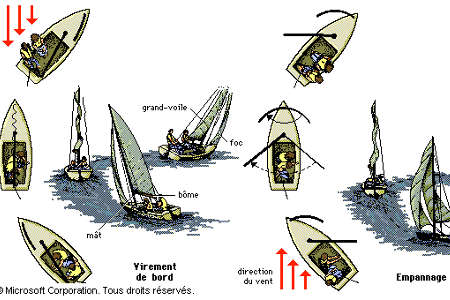Tacking is a basic maneuver that is relatively easy to perform even in strong winds, provided the crew achieves good coordination.
Here, the boom passes over the deck but will not sweep everything in its path.
This is why tacking is preferred over jibing when switching sides in strong winds.
Tacking is strongly recommended starting at Force 5 for intermediate crew members and Force 6 for experienced sailors.
tacking - video sailing online
Definition
Tacking on a sailboat involves switching from one tack to the other with the wind coming from the front.
The sails will change sides, just like in a jibe.


In the case of a tack, a maneuver where the boom’s movement is less violent than during a jibe, where the boat also changes tack.
Simply ensure that no one is in the path of the boom, standing on the deck, or positioned too high in the cockpit. Taller individuals should make sure to duck or be seated during the tack.
One person at each genoa winch, depending on the number of crew members available.
One person managing the mainsail sheet and traveler.
The helmsman directs the maneuver.
No one should sit near the mainsheet traveler.
Those not participating in the maneuver should position themselves at the stern or inside the boat.
A cautious helmsman is worth two...
During a tack, the boat must cross the wind’s path without any propulsion other than the momentum (speed) it has built up. To avoid stalling in the wind’s eye mid-maneuver, the boat’s speed must be maximized, especially to handle waves when the sea is rough.
To achieve this, position the boat on a close-hauled course, between 45 and 60° to the wind (the wind vane points towards the forward quarter of the boat). This is the point of sail where the boat heels the most.
Nota bene
If the boat "straightens up" and the wind vane points almost directly forward, the helmsman is too close to the wind. In this case, the boat needs to bear away (turn away from the wind) to regain enough speed for tacking.
If the boat "straightens up" and the wind vane is perpendicular to the boat or slightly aft, the helmsman is too far from the wind. They should head up (turn towards the wind) and return to a close-hauled course to regain sufficient speed for tacking.
- Check that the mainsail and genoa sheets are coiled and ready to run freely.
- The helmsman brings the boat to a close-hauled position, with the wind vane pointing towards the forward quarter of the boat (crew members trim the sails as needed to maximize the boat's speed).
- The helmsman announces the maneuver clearly to the crew by asking, “Ready to tack?”
- The leeward genoa trimmer (responsible for releasing the sheet) ensures the sheet is clear, removes one turn from the winch while keeping tension to maintain the genoa's shape, and then signals “Ready” to the helmsman.
- The windward genoa trimmer (responsible for trimming the new sheet) wraps two clockwise turns on the winch and signals “Ready” to the helmsman.
- The mainsail trimmer ensures the mainsail is properly set, and that the sheet and traveler lines are clear and ready to run, then signals “Ready” to the helmsman.
- The helmsman announces, “Tacking!” clearly to the crew, then turns the wheel or tiller hard over to bring the boat quickly into the wind.
- As the genoa luffs, the leeward trimmer quickly releases the sheet, ensuring it runs smoothly through the fairlead.
Nota bene:
In strong winds, leave one or two turns on the genoa sheet so the winch absorbs the sail’s jerks. Once the tension is manageable, remove the remaining turns to release the sheet. This technique does not delay the tack if done correctly.
- When the sails cross from port to starboard or vice versa, the helmsman straightens the wheel or tiller to maintain a close-hauled course (boat-to-wind angle between 45 and 60°, with the wind vane pointing towards the forward quarter of the boat).
- The new windward genoa trimmer pulls in the sheet (recovers slack) with large, controlled movements.
Nota bene:
Step one foot back to maintain balance and avoid falls. Alert nearby crew to move aside to prevent accidental elbow strikes (ouch).
- Align the boat on its new course.
- Trim the sails for the new point of sail and resume the route.
Tacking is a basic maneuver that is relatively easy to perform even in strong winds, provided the crew achieves good coordination.
Here, the boom passes over the deck but will not sweep everything in its path.
This is why tacking is preferred over jibing when switching sides in strong winds.
Tacking is strongly recommended starting at Force 5 for intermediate crew members and Force 6 for experienced sailors.
tacking - video sailing online
Definition
Tacking on a sailboat involves switching from one tack to the other with the wind coming from the front.
The sails will change sides, just like in a jibe.


In the case of a tack, a maneuver where the boom’s movement is less violent than during a jibe, where the boat also changes tack.
Simply ensure that no one is in the path of the boom, standing on the deck, or positioned too high in the cockpit. Taller individuals should make sure to duck or be seated during the tack.
One person at each genoa winch, depending on the number of crew members available.
One person managing the mainsail sheet and traveler.
The helmsman directs the maneuver.
No one should sit near the mainsheet traveler.
Those not participating in the maneuver should position themselves at the stern or inside the boat.
A cautious helmsman is worth two...
During a tack, the boat must cross the wind’s path without any propulsion other than the momentum (speed) it has built up. To avoid stalling in the wind’s eye mid-maneuver, the boat’s speed must be maximized, especially to handle waves when the sea is rough.
To achieve this, position the boat on a close-hauled course, between 45 and 60° to the wind (the wind vane points towards the forward quarter of the boat). This is the point of sail where the boat heels the most.
Nota bene
If the boat "straightens up" and the wind vane points almost directly forward, the helmsman is too close to the wind. In this case, the boat needs to bear away (turn away from the wind) to regain enough speed for tacking.
If the boat "straightens up" and the wind vane is perpendicular to the boat or slightly aft, the helmsman is too far from the wind. They should head up (turn towards the wind) and return to a close-hauled course to regain sufficient speed for tacking.
- Check that the mainsail and genoa sheets are coiled and ready to run freely.
- The helmsman brings the boat to a close-hauled position, with the wind vane pointing towards the forward quarter of the boat (crew members trim the sails as needed to maximize the boat's speed).
- The helmsman announces the maneuver clearly to the crew by asking, “Ready to tack?”
- The leeward genoa trimmer (responsible for releasing the sheet) ensures the sheet is clear, removes one turn from the winch while keeping tension to maintain the genoa's shape, and then signals “Ready” to the helmsman.
- The windward genoa trimmer (responsible for trimming the new sheet) wraps two clockwise turns on the winch and signals “Ready” to the helmsman.
- The mainsail trimmer ensures the mainsail is properly set, and that the sheet and traveler lines are clear and ready to run, then signals “Ready” to the helmsman.
- The helmsman announces, “Tacking!” clearly to the crew, then turns the wheel or tiller hard over to bring the boat quickly into the wind.
- As the genoa luffs, the leeward trimmer quickly releases the sheet, ensuring it runs smoothly through the fairlead.
Nota bene:
In strong winds, leave one or two turns on the genoa sheet so the winch absorbs the sail’s jerks. Once the tension is manageable, remove the remaining turns to release the sheet. This technique does not delay the tack if done correctly.
- When the sails cross from port to starboard or vice versa, the helmsman straightens the wheel or tiller to maintain a close-hauled course (boat-to-wind angle between 45 and 60°, with the wind vane pointing towards the forward quarter of the boat).
- The new windward genoa trimmer pulls in the sheet (recovers slack) with large, controlled movements.
Nota bene:
Step one foot back to maintain balance and avoid falls. Alert nearby crew to move aside to prevent accidental elbow strikes (ouch).
- Align the boat on its new course.
- Trim the sails for the new point of sail and resume the route.